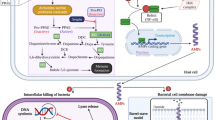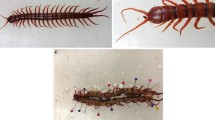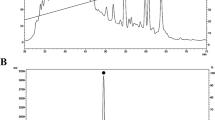Abstract
The present study deals with molecular nature and peculiarities of the functioning of two main protective systems of larvae Lucilia sericata—the antimicrobial compounds of haemolymph and exosecretion released by feeding larvae into environment. In the haemolymph of larvae undergone to bacterial infestation, the chromato-masspectrometry methods identified a set of inducible antibacterial peptides including defensins (3844, 4062, and 4117 Da), P-peptide (3043 Da), and four new polypeptides (3235, 3702, 3746, and 3768 Da). The exosecretion of Lucilia sericata maggots contains the peptides analogous or identical to the haemolymph antimicrobial peptides (diptericins: 8882 Da and 9025 Da), high molecular compounds of the peptide nature (6466 Da, 6633 Da, 5772 Da, 8631 Da, etc.) differing from the known haemolymph components, and the low molecular compounds (130–700 Da). The spectrum of exosecretion bactericidal activity includes the representatives of various groups of bacteria including pathogen the most actual from the medical point of view-the methicillin-resistant Staphylococcus aureus that does not have anti-staphylococcal activity in contrast to haemolymph. The exosecretion components suppressing growth and development of this staphylococcus represent the substances of low molecular mass (from 160 to 1020 Da). The performed studies characterize the strategies used by “surgical maggots” for protection from pathogens and for suppression of microbial competitors, and allow better understanding of molecular mechanisms of larval therapy of purulent infectious diseases. These studies in perspective can serve the basis for creation of the principally new drugs for struggle with usual and antibiotics-resistant bacterial infections.
Similar content being viewed by others
References
Whitaker, I.S., Twine, C., Whitaker, M.J., Welck, M., Brown, C.S., and Shandall, A., Larval Therapy from Antiquity to Present Day: Mechanisms of Action, Clinical Application and Future Potential, Postgrad. Med. J., 2007, vol. 83, pp. 409–413.
Nigam, Y., Bexfield, A., Thomas, S., and Ratcliffe, N.A., Maggot Therapy: the Science and Implication for CAM. Part I-History and Bacterial Resistance, eCAM, 2006, vol. 3, no. 2, pp. 223–227.
Thomas, S., Andrews, A., Hay, P., and Bourgoise, S., The Anti-Microbial Activity of Maggot Secretions: Results of a Preliminary Study, J. Tissue Viabil., 1999, vol. 9, pp. 127–132.
Bexfield, A., Nigam, Y., Thomas, S., and Ratcliffe, N.A., Detection and Partial Characterization of Two Antibacterial Factors from the Excretions/Secretions of the Medicinal Maggot Lucilia sericata and Their Activity Against Methicillin-Resistant Staphylococcus aureus (MRSA), Microbes and Infection, 2004, vol. 6, pp. 1297–1304.
Mumcuoglu, K., Miller, J., Mumcuoglu, M., Friger, F., and Tarshis, M., Destruction of Bacteria in the Digestive Tract of the Maggot of Lucilia sericata (Diptera: Calliphoridae), J. Med. Entomol., 2001, vol. 38, pp. 161–166.
Kerridge, A., Lappin-Scott, H., and Stevens, J.R., Antibacterial Properties of Larval Secretions of the Blowfly, Lucilia sericata, Med. Vet. Entomol., 2005, vol. 19, pp. 333–337.
Tzou, P., Ohresser, S., Ferrandon, D., Capovilla, M., Reichhart, J.-M., Lemaitre, B., Hoffmann, J.A., and Imler, J.-L., Tissue-Specific Inducible Expression of Antimicrobial Peptide Genes in Drosophila Surface Epithelia, Immunity, 2000, vol. 13, pp. 737–748.
Chicz, R.M. and Regnier, F.E., High-Performance Liquid Chromatography: Effective Protein Purification by Various Chromatographic Modes, J. Methods Enzymol., 1990, vol. 182, pp. 392–421.
Lambert, J., Keppi, E., Dimarcq, J.-L., Wicker, C., Reichhart, J.-M., Dunbar, B., Lepage, P., Dorsselaer, A.V., Hoffmann, J., Fothergilli, J., and Hoffmann, D., Insect Immunity: Isolation from Immune Blood of the Dipteran Phormia terranovae of Two Insect Antibacterial Peptides with Sequence Homology to Rabbit Lung Macrophage Bactericidal Peptides, Proc. Nat. Acad. Sci. USA, 1989, vol. 86, pp. 262–266.
Gross, J.H., Mass Spectrometry: a Textbook, Heidelberg: Springer, 2004.
Hoffmann, J.A., Innate Immunity of Insects, Current Opinion in Immunology, 1995, vol. 7, pp. 4–10.
Cazander, G., van Veen, K.E.B., Bernards, A.T., and Jukema, G.N., Do Maggots Have an Influence on Bacterial Growth? A Study on the Susceptibility of Strains of Six Different Bacterial Species to Maggots of Lucilia sericata and Their Secretions/Excretions, J. Tissue Viabil., 2009, vol. 18, no. 3, pp. 80–87.
Jaklic, D., Lapanje, A., Zupancic, K., Smrke, D., and Gunde-Cimerman, N., Selective Antimicrobial Activity of Maggots Against Pathogenic Bacteria, J. Med. Microbiol., 2008, vol. 57, pp. 617–625.
van der Plas, M.J.A., van der Does, A.M., Baldry, M., Dogterom-Ballering, H.C.M., van Gulpen, C., van Dissel, J.T., Nibbering, P.H., and Jukema, G.N., Maggot Excretions/Secretions Inhibit Multiple Neutrophil Pro-Inflammatory Responses, Microbes and Infection, 2007, vol. 9, pp. 507–514.
Constable, S.A., A Comparison of Proteases Produced by Larvae of Lucilia cuprina (Wiedemann), L. sericata (Meigen), Calliphora augur (F.) and C. stygia (F.) (Diptera: Calliphoridae), J. Aust. Ent. Soc., 1994, vol. 33, pp. 203–210.
Wolfff, H. and Hansson, C., Larval Therapy for a Leg Ulcer with Methicillin-Resistant Staphyloccocus aureus, Acta Derm. Venerol., 1999, vol. 79, pp. 320–335.
Chernysh, S.I., Gordja, N.A., and Simonenko, N.P., Diapause and Immune Response: Induction of Antimicrobial Peptide Synthesis in the Blowfly, Calliphora vicina R.-D. (Diptera, Calliphoridae), Entomol. Sci., 2000, vol. 3, no. 1, pp. 139–144.
Cherrnysh, S.I., Gordja, N.A., Nesin, A.P., Simonenko, N.P., Tulin, D.V., and Yakovlev, A.Yu., Immune System of Insects as a Source of New Therapeutic Compounds, Fundamental Basis of Innovative Biological Projects in “Naukograd”, Trudy Biol. Nauch.-Issled. In-ta SPBGU, 2008, Iss. 54, pp. 150–155.
Cerovsky, V., Zdarek, J., Fucik, V., Monincova, L., Voburka, Z., and Bem, R., Lucifensin, the Long-Sought Antimicrobial Factor of Medicinal Maggots of the Blowfly Lucilia sericata, Cell. Mol. Life Sci., 2010, vol. 67, pp. 455–466.
Altincicek, B. and Vilcinskas, A., Septic Injury-Inducible Genes in Medicinal Maggots of the Green Blow Fly Lucilia sericata, Ins. Mol. Biol., 2009, vol. 18, no. 1, pp. 119–125.
Huberman, L., Gollop, N., Breuer, E., Bhusare, S.R., Shai, Y., and Galun, R., Antibacterial Substances of Low Molecular Weight Isolated from the Blowfly, Lucilia sericata, Med. Vet. Entomol., 2007, vol. 21, pp. 127–131.
Bexfield, A., Bond, E., Roberts, E.C., Dudley, E., Nigam, Y., Thomas, S., Newton, R.P., and Ratcliffe, N.A., The Antibacterial Activity against MRSA Strains and Other Bacteria of a Less than 500 Da Fraction from Maggot Excretions/Secretions Lucilia sericata (Diptera: Calliphoridae), Microbes and Infection, 2008, vol. 10, pp. 325–333.
Author information
Authors and Affiliations
Corresponding author
Additional information
Original Russian Text © A. A. Kruglikova, 2011, published in Zhurnal Evolyutsionnoi Biokhimii i Fiziologii, 2011, vol. 47, no. 6, pp. 453–460.
To the 100th Anniversary of A.S. Danilevsky
Rights and permissions
About this article
Cite this article
Kruglikova, A.A. Antimicrobial components of haemolymph and exosecretion of larvae Lucilia sericata (Meigen) (Diptera, Calliphoridae). J Evol Biochem Phys 47, 534–542 (2011). https://doi.org/10.1134/S0022093011060044
Received:
Published:
Issue Date:
DOI: https://doi.org/10.1134/S0022093011060044




